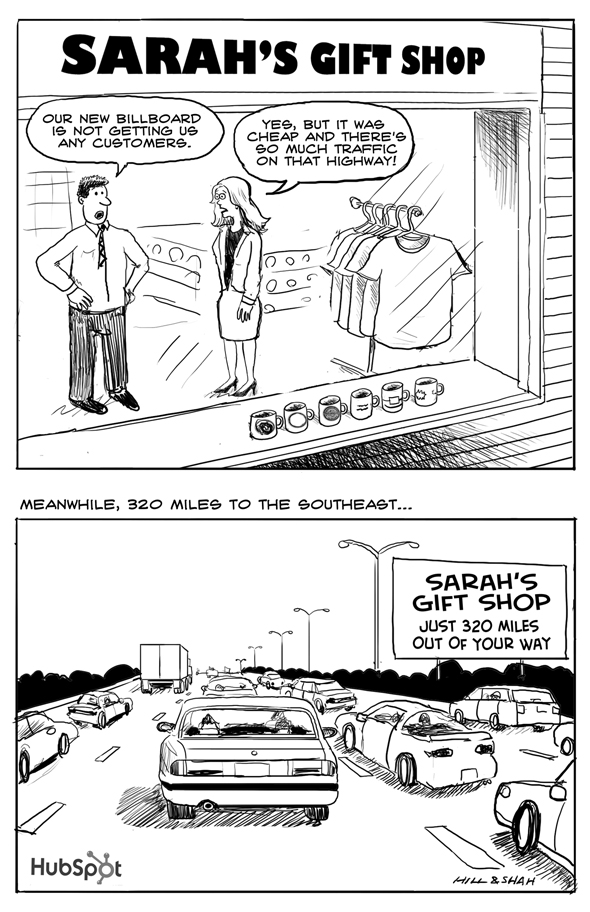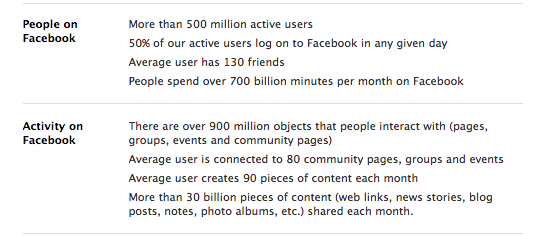Guest Post by Howie Goldfarb
If you read the news or popular blogs, you get a lot of numbers thrown at you.
Social media talking heads and agencies will use fancy numbers because they look impressive, and it benefits their businesses.
Social networks will also do the same, partially to attract news coverage, members, and investors.
But those numbers do nothing for your business.
It is important to have clearly stated goals for your own needs.
If you have a small business with a storefront in a small town, do 600 million Facebook accounts do you any good?
Does tweeting “specials” when only 25 Twitter users are within driving distance help you sell more?
Cartoon: HubSpot via Flickr, CC 2.0
It is really easy to do some math to get through the numbers.
In April 2010, Facebook had a statistic that said users spend 55 minutes each on the site per day.
Now they say 700 billion minutes per month. Sounds way more impressive.
But if you divide 700 billion by the 600 million users they now claim, that is 38 minutes per person per day.
What about 30 billion pieces of content exchanged per month on Facebook?
30 billion ÷ 600 million = 50 pieces of content per person per month.
Think of that.
For every Facebook account, less than 2 pieces of content are shared each day.
Think of all the content out there.
What will get a person to share your content as part of the 1.7 they share in a day?
Think of all the content you will see today. Hundreds? Thousands? Yet, will you share only 1.7 pieces on Facebook?
Now, again, Facebook claims 600 million accounts.
They refuse to say how many are spam accounts (I bet six figures or more). Half of these accounts are logged into each day.
But Compete says Facebook gets 134 million unique visitors in the US each month.
Supposedly half of these log in.
That is 67 million. A big pool, to be sure.
But there are 250 million consumers over the age of 14 in the US.
So 73% of all U.S. consumers will not be using Facebook today… but most of them will be watching TV.
Do we know how many of the 67 million just log in for 5 minutes?
And how many are on the site all day?
67 million x 38 minutes = 2.546 billion minutes a day.
Say just 1 million stay logged in for 8 hours, the rest would average 31 minutes.
If 10 million logged in for 8 hours, the rest would average only three minutes on the site.
Do you see where I’m going with this?
Another example is Yelp! I came across this Small Business Trends article about Yelp! Mobile, and here are the key data:
First off let me say that I love the Yelp! mobile app. I don’t use it very often, but when I am out and about I do.
The purpose here is not to say don’t have your business listed.
I just want you to learn how to analyze numbers for proper perspective.
So let’s run through these again:
- What is “every other second”? 30 seconds x 60 minutes x 24 hours = 43,200 actions per day.
- Divide that by 50 states in the U.S. = 864 actions per state per day.
So, you could also read this as: in the U.S., in each state, only 864 businesses get a phone call or generate directions per day.
Isn’t that almost zero?
- 35% of all searches on Yelp.com come from its mobile app.
They do not tell us how many searches occur each day; 1 million equaling 350,000, or 100 equaling 35?
- Lastly a photo is uploaded to Yelp! every 30 seconds.
- 60 minutes x 24 hours x 2 (2 per minute) = 2,880 photos per day
- 2,880 divided by 50 states = 57.6 photos per day per state.
Yes each state has different population sizes, but I am trying to take away the awe presented to you in numbers that are given from biased sources.
It is all perspective,
and as a business owner or strategist you need to cut through the fluff and look at things properly so you can decide the value of every marketing channel out there.
It’s simple math. Don’t be intimidated.
 Howie Goldfarb is Vice President of Marketing and Corporate Strategy at Web Choice Consulting, a full service integrated marketing and Internet agency. He had a 14-year career in direct B2B industrial sales before deciding to lighten up his dreary work life and move into advertising/marketing. He has a CFO’s view of marketing, bringing a dose of reality to the confusing world of jargon, spin, and hype. He currently lives in the Green Mountains of Vermont and is still seeking his first moose sighting.
Howie Goldfarb is Vice President of Marketing and Corporate Strategy at Web Choice Consulting, a full service integrated marketing and Internet agency. He had a 14-year career in direct B2B industrial sales before deciding to lighten up his dreary work life and move into advertising/marketing. He has a CFO’s view of marketing, bringing a dose of reality to the confusing world of jargon, spin, and hype. He currently lives in the Green Mountains of Vermont and is still seeking his first moose sighting.











[…] who are in the online social networks. They are pulling back from who, what and how they are spending their time online. Large numbers of people who have been online for more than a year are purging their […]
@HowieSPM Woo hoo! I’ll slip you that $10 later, Howie. :p
@Shonali @ginidietrich yes I have the best editor by far.
@ginidietrich I’m going to take credit for that, as @HowieSPM ‘s editor. :p Isn’t it, though?!
And Howie, look at you, getting kudos from the “public radio” brigade. Way to go!
@HowieSPM @markwschaefer Howie, I would treasure this moment. You made Mark proud.
That image is HILARIOUS!
I hear you @HowieSPM . So tired of the folks who are selling the snake oil.
@jenzings You got it Jen! Think about the pressure Mark Zuckerberg has on him for taking so much money. Some of it Chinese and Russian..ahem almost mafia money..then Goldman Sachs Banking Mafia money. They really only care about going public selling out and taking off. What drives me crazy is many marketers who create spin to hook consumers get taken in by spin as well. Cheers!
@markwschaefer Mark! you are too kind. Figured would get me back by writing a book! LOL Something I have wanted to write about for awhile. Cheers.
@mdbarber Hi Mary thank you for the comment. I just want people to not believe everything thrown their way or at least think about things relative to their own goals and needs.
You can also hide a lot in numbers, which I think you are saying without being as blunt as I’m being.
Using your Facebook metric, did they switch from 55 minutes average on site in April 2010 to the 700 billion minutes per month, not because it sounds more impressive, but because if the average number of minutes per day has gone down from 55 min./day to 38 min./day, advertisers might start thinking people aren’t “sticky” enough in FB to justify advertising there, causing a rapid downturn? Very interesting post.
Hurray Howie. Common sense! Analytical thinking! How very refreshing on the social web.
This is a really interesting post and will, I can hope anyway, cause people to think a bit before jumping in the water. You can prove almost any point with numbers and that is compelling to many but really only a fraction of the picture. I’ll be passing this on to many I hope will think about jumping in more strategically.
@johnfalchetto John thanks for commenting! Its funny because I have a Finance Degree I should of been a Stock Broker/Analyst. People forget when these companies go public all the dirty laundry comes out. BUT does mean someone like Goldman Sachs doesn’t see a bunch of suckers who will buy Facebook’s IPO in a pump and dump.
Ask @ginidietrich to email you the email I sent her!
Howie, thanks for this post. You are right people are throwing numbers around like they mean something. With numbers you can prove almost anything, even make disastrous results look good. Enron?
THanks for the little reminder and loved that Camry in the desert